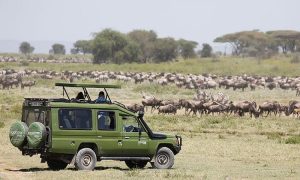Overview of Ngorongoro Conservation Area
Ngorongoro Conservation Area, located in northern Tanzania, is a UNESCO World Heritage Site that is renowned for its stunning natural beauty and rich biodiversity. Spanning over 8,000 square kilometers, the area is home to the world-famous Ngorongoro Crater, a large volcanic caldera that is often referred to as the "eighth wonder of the world."
The Ngorongoro Crater is the largest intact caldera in the world, with a diameter of approximately 19 kilometers and a depth of over 600 meters. The crater is home to a wide variety of wildlife, including lions, elephants, buffalo, and rhinos, as well as hundreds of bird species. It is truly a wildlife enthusiast’s paradise, offering visitors the chance to see some of Africa’s most iconic animals in their natural habitat.
In addition to the Ngorongoro Crater, the conservation area also includes the surrounding highlands, forests, and plains, each offering a unique and diverse ecosystem. The area is also home to the Maasai people, a semi-nomadic tribe who have been living in harmony with the wildlife for centuries.
Evolution of Ngorongoro’s Natural Heritage
The history of Ngorongoro Conservation Area dates back millions of years, to when the region was formed by volcanic activity. The Ngorongoro Crater itself was created around three million years ago, when a massive volcano erupted and collapsed in on itself, forming the caldera that we see today.
Over the years, the area has been home to a variety of different wildlife species, each adapting to the unique environment of the crater and its surroundings. The Maasai people have also played a significant role in the conservation of the area, living in harmony with the wildlife and helping to protect the land from human encroachment.
In 1959, Ngorongoro Conservation Area was officially established by the Tanzanian government, with the goal of preserving the area’s natural beauty and biodiversity for future generations. In 1979, the area was designated a UNESCO World Heritage Site, recognizing its importance as a unique and irreplaceable ecosystem.
Today, visitors to Ngorongoro Conservation Area can explore the stunning landscapes, observe the incredible wildlife, and experience the rich Maasai culture that has been a part of the area for centuries. Sunset Africa Safari offers guided tours of the area, providing visitors with the opportunity to learn about the history and significance of Ngorongoro Conservation Area from knowledgeable guides.
For booking requests or more information about Sunset Africa Safari’s tours of Ngorongoro Conservation Area, clients can contact info@sunsetafricasafari.com. Don’t miss the chance to explore this incredible natural wonder and experience the beauty of Ngorongoro for yourself.


